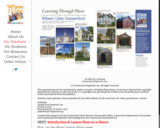
10 lesson plans for use with Where I Live: Connecticut
- Subject:
- English Language Arts
- History
- Social Science
- Material Type:
- Unit of Study
- Provider:
- Connecticut Explored
- Author:
- Elizabeth Normen
- Mary Donohue
- Date Added:
- 07/29/2018

10 lesson plans for use with Where I Live: Connecticut

Uses primary
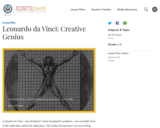
Students discover why Leonardo is considered the ultimate Renaissance man. They will learn about his famous notebooks, focusing upon his machines of motion, then zooming in on the flying machines.
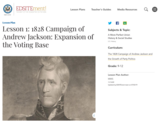
Did changes in state constitutions tend to affect the voting population? In this lesson, students discuss the general trend in the first half of the 19th century to extend the right to vote to more white males.
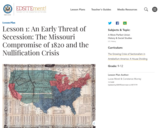
Americans affirmed their independence with the ringing declaration that "all men are created equal." Some of them owned slaves, however,and were unwilling to give them up as they gave speeches and wrote pamphlets championing freedom, liberty, and equality. So "to form a more perfect union" in 1787, certain compromises were made in the Constitution regarding slavery. This settled the slavery controversy for the first few decades of the American republic, but this situation changed with the application of Missouri for statehood in 1819.
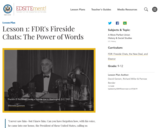
In this lesson, students gain a sense of the dramatic effect of FDR's voice on his audience, see the scope of what he was proposing in these first two "Fireside Chats," and make an overall analysis of why the series of speeches were so successful.
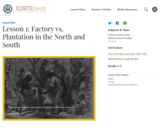
This lesson focuses on the shift toward mass production in northern factories and on southern plantations that occurred during the first half of the 19th century. Using an economics-focused approach to examining U.S. history prior to the civil war, students examine the role of slavery, industrialization, regionalism, and political responses that ultimately led to the start of a war.
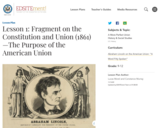
How did Abraham Lincoln understand the relationship between principles of the Declaration of Independence and the U.S. Constitution?
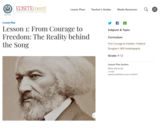
Students examine the Autobiography of Frederick Douglass to discover how his skilled use of language painted a realistic portrait of slavery and removed some common misconceptions about slaves and their situation.
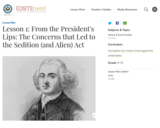
What conditions provided the impetus for the Sedition Act? Partisan animosity was strong during Adams's presidency. The first two political parties in the U.S. were in their infancy"”the Federalists, to which the majority of members of Congress belonged, and the Democratic-Republicans, led by former vice-president Thomas Jefferson and four-term Congressman James Madison, who had left the House in 1796.
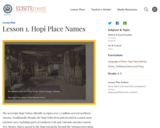
A guided exploration of "Hopitutskwa," the Hopi homeland, through maps and place names. Using English translations, students make inferences about the Hopi cultural relationship to landscape and place. They examine regional place names of their own home communities and create personal maps by identifying and naming places of importance in their lives.
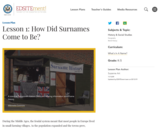
During the Middle Ages, the feudal system meant that most people in Europe lived in small farming villages. As the population expanded and the towns grew, however, a need arose to find ways to differentiate between two people who shared the same first name.
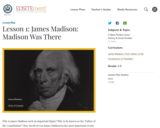
Why is James Madison such an important figure? Why is he known as the "Father of the Constitution"? How involved was James Madison in the most important events in America from 1775 to 1817? The answers to these questions provide context for understanding the importance of James Madison's opinions on constitutional issues.
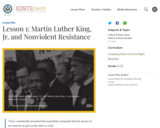
By examining King's famous essay in defense of nonviolent protest, along with two significant criticisms of his direct action campaign, this lesson will help students assess various alternatives for securing civil rights for black Americans in a self-governing society.

This lesson focuses on the constitutional arguments for and against the enactment of federal anti-lynching legislation in the early 1920s. Students will participate in a simulation game that enacts a fictitious Senate debate of the Dyer Anti-Lynching Bill. As a result of completing this activity, students will gain a better understanding of the federal system, the legislative process, and the difficulties social justice advocates encountered.
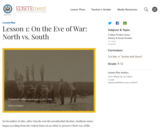
This lesson will examine the economic, military and diplomatic strengths and weaknesses of the North and South on the eve of the Civil War. In making these comparisons students will use maps and read original documents to decide which side, if any, had an overall advantage at the start of the war.
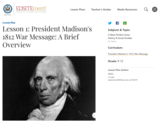
Students will read President Madison's War Message (in either an edited/annotated or full-text version) and be given the opportunity to raise questions about its contents.
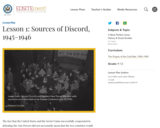
The fact that the United States and the Soviet Union successfully cooperated in defeating the Axis Powers did not necessarily mean that the two countries would continue to get along in the postwar world. This lesson will examine the U.S.-Soviet disagreements regarding Germany and Eastern Europe.
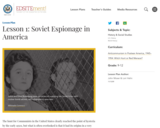
The hunt for Communists in the United States clearly reached the point of hysteria by the early 1950s, but what is often overlooked is that it had its origins in a very real phenomenon. This lesson will expose students to recently declassified FBI documents and transcripts of the Rosenberg trial. It will encourage them to think seriously about the extent of the Soviet espionage network in America, thus setting the stage for a proper understanding of later hearings by the House Un-American Activities Committee and Joseph McCarthy.
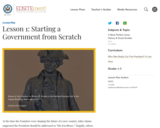
What actions are necessary in order to start a new government? What would one of the major concerns be in preserving the new government and country? What would be the role of the leader or president of the country?